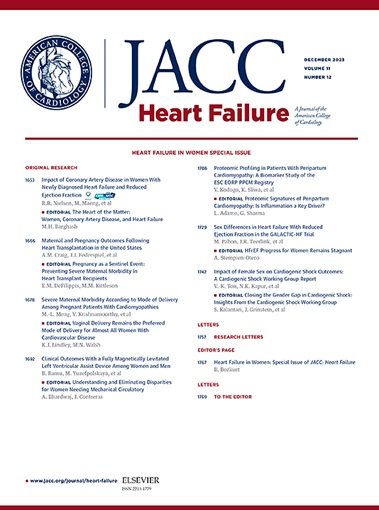射血分数减低的慢性心力衰竭患者的最佳药物治疗和疗效。
IF 10.3
1区 医学
Q1 CARDIAC & CARDIOVASCULAR SYSTEMS
引用次数: 0
摘要
背景:最佳医疗疗法(OMT)评分可通过整合射血分数降低的慢性心力衰竭(HFrEF)指南指导医疗疗法(GDMT)的使用和剂量,对真实世界中的临床风险进行分层:本研究的目的是通过 OMT 评分得出的治疗组别来描述患者的特征和相关的长期临床结果:CHAMP-HF(Change the Management of Patients with Heart Failure,改变心衰患者的管理)纳入了接受≥1次GDMT治疗的美国慢性HFrEF门诊患者。OMT亚组被定义为次优(评分结果:作者研究了 4,582 名参加了 CHAMP-HF 并进行了两年随访的患者。中位年龄为 68 岁,1,327 人(29%)为女性,2,842 人(62%)为非西班牙裔白人。整个人群的 OMT 评分中位数为 4(Q1-Q3:2-5),1628 人(35%)接受了次优治疗,665 人(14%)接受了可接受治疗,2289 人(50%)接受了最佳治疗。与接受可接受治疗或次优治疗的参试者相比,接受最佳治疗的参试者更年轻、家庭年收入更高,且来自设有专门心房颤动诊所的医疗机构(所有 P 均小于 0.001)。与接受次优治疗者相比,接受最优治疗者的全因死亡(调整后HR:0.77;95% CI:0.64-0.92)和心血管死亡(调整后HR:0.79;95% CI:0.65-0.96)更低:结论:在一个大型慢性非卧床 HFrEF 队列中,OMT 评分可对全因死亡和心血管死亡的风险进行分层。本文章由计算机程序翻译,如有差异,请以英文原文为准。
Optimal Medical Therapy and Outcomes Among Patients With Chronic Heart Failure With Reduced Ejection Fraction
Background
Optimal medical therapy (OMT) scoring may stratify clinical risk in real-world chronic heart failure with reduced ejection fraction (HFrEF) by integrating use and dosing of guideline-directed medical therapy (GDMT) for HFrEF.
Objectives
The purpose of this study was to characterize patients and associated long-term clinical outcomes by OMT score-derived treatment groups.
Methods
CHAMP-HF (Change the Management of Patients with Heart Failure) included U.S. outpatients with chronic HFrEF receiving ≥1 GDMT. OMT subgroups were defined as suboptimal (score <3), acceptable (score = 3), and optimal (score ≥4) by baseline use and dose of GDMT, as proposed by the HF Collaboratory consortium. Cox proportional hazard analyses were used to assess for all-cause and cardiovascular death across subgroups, after adjusting for demographic and clinical covariates.
Results
The authors studied 4,582 participants enrolled in CHAMP-HF with available 2-year follow-up. Median age was 68 years, 1,327 (29%) were women, and 2,842 (62%) were White, non-Hispanic. Median OMT score across the population was 4 (Q1-Q3: 2-5), and 1,628 (35%) had suboptimal, 665 (14%) had acceptable, and 2,289 (50%) had optimal therapy. Participants with optimal treatment were younger, had higher annual household income, and were enrolled from practices with dedicated HF clinics (all P < 0.001) than participants with acceptable or suboptimal treatment. Participants with optimal treatment had lower all-cause death (adjusted HR: 0.77; 95% CI: 0.64-0.92) and cardiovascular death (adjusted HR: 0.79; 95% CI: 0.65-0.96) than those with suboptimal treatment.
Conclusions
Across a large cohort of chronic ambulatory HFrEF, OMT scores stratified risk of all-cause and cardiovascular death.
求助全文
通过发布文献求助,成功后即可免费获取论文全文。
去求助
来源期刊

JACC. Heart failure
CARDIAC & CARDIOVASCULAR SYSTEMS-
CiteScore
21.20
自引率
2.30%
发文量
164
期刊介绍:
JACC: Heart Failure publishes crucial findings on the pathophysiology, diagnosis, treatment, and care of heart failure patients. The goal is to enhance understanding through timely scientific communication on disease, clinical trials, outcomes, and therapeutic advances. The Journal fosters interdisciplinary connections with neuroscience, pulmonary medicine, nephrology, electrophysiology, and surgery related to heart failure. It also covers articles on pharmacogenetics, biomarkers, and metabolomics.
 求助内容:
求助内容: 应助结果提醒方式:
应助结果提醒方式:


